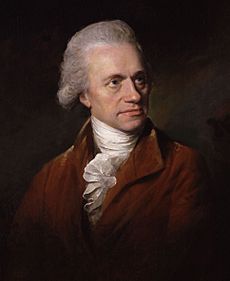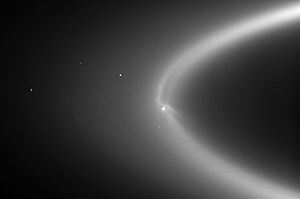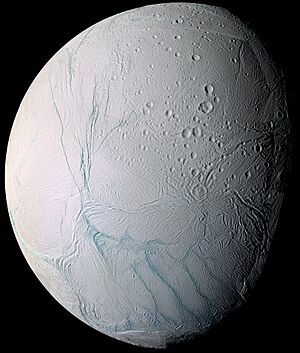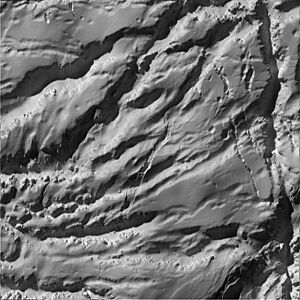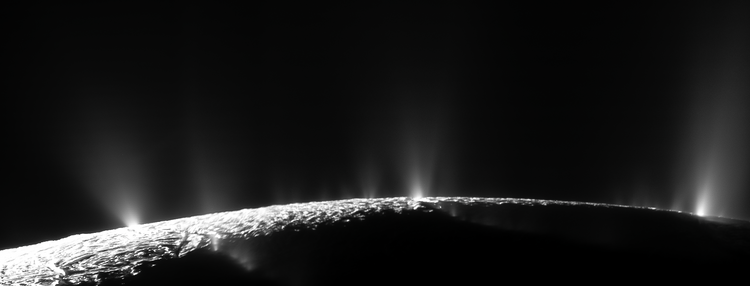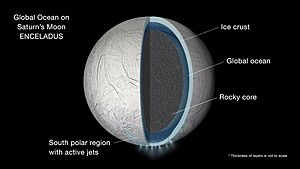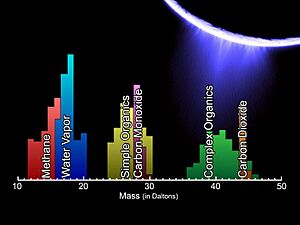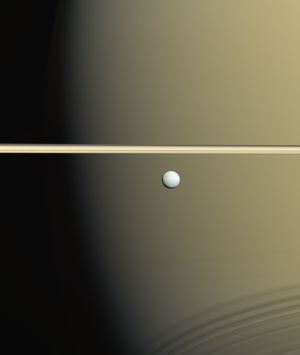Enceladus facts for kids
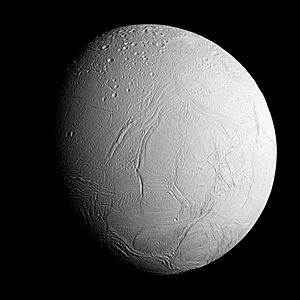
Enceladus seen by the Cassini spacecraft in October 2015.
|
|||||||||||||
| Discovery | |||||||||||||
|---|---|---|---|---|---|---|---|---|---|---|---|---|---|
| Discovered by | William Herschel | ||||||||||||
| Discovery date | August 28, 1789 | ||||||||||||
| Designations | |||||||||||||
| MPC designation | Saturn II | ||||||||||||
|
Named after
|
Ἐγκέλαδος Enkélados | ||||||||||||
| Adjectives | Enceladean | ||||||||||||
| Orbital characteristics | |||||||||||||
| 238037 km | |||||||||||||
| Eccentricity | 0.0047 | ||||||||||||
| 1.370218 d | |||||||||||||
| Inclination | 0.009° (to Saturn's equator) | ||||||||||||
| Satellite of | Saturn | ||||||||||||
| Physical characteristics | |||||||||||||
| Dimensions | 513.2 × 502.8 × 496.6 km | ||||||||||||
|
Mean radius
|
252.1±0.2 km (0.0395 Earths, 0.1451 Moons) | ||||||||||||
| Mass | (1.080318±0.00028)×1020 kg (1.8×10−5 Earths) | ||||||||||||
|
Mean density
|
1.6097±0.0038 g/cm3 | ||||||||||||
| 0.113 m/s2 (0.0116 g) | |||||||||||||
|
Moment of inertia factor
|
0.3305±0.0025 | ||||||||||||
| 0.239 km/s (860.4 km/h) | |||||||||||||
| Synchronous | |||||||||||||
| < 0.05° | |||||||||||||
| Albedo | 1.375±0.008 (geometric at 550 nm) or 0.81±0.04 (Bond) | ||||||||||||
|
|||||||||||||
| 11.7 | |||||||||||||
| Atmosphere | |||||||||||||
|
Surface pressure
|
Trace, significant spatial variability | ||||||||||||
| Composition by volume | 91% water vapor 4% nitrogen 3.2% carbon dioxide 1.7% methane |
||||||||||||
Enceladus is the sixth-largest moon of Saturn and one of the most interesting worlds in our Solar System. It is a small moon, only about 500 kilometers (310 miles) wide, which is about one-tenth the size of Saturn's largest moon, Titan.
Enceladus is covered in a thick layer of clean, fresh ice and snow, making it one of the brightest and most reflective objects in the Solar System. Because it reflects so much sunlight, its surface is extremely cold, with temperatures dropping to about -198°C (-324°F).
Despite its small size and icy surface, Enceladus is surprisingly active. In 2005, the Cassini spacecraft discovered that Enceladus shoots huge jets of water vapor and ice particles into space from its south pole. These jets, called plumes, come from a giant ocean of liquid salt water hidden beneath its icy shell. This discovery makes Enceladus one of the most likely places in the Solar System to find life beyond Earth.
Contents
History of Enceladus
How Was Enceladus Discovered?
Enceladus was discovered by the astronomer William Herschel on August 28, 1789. He used his powerful new telescope, which was the largest in the world at the time.
For a long time, Enceladus was very hard to see from Earth because it is so small and close to the bright rings of Saturn. It wasn't until the Voyager spacecraft flew by in the 1980s that we got our first good look at this icy moon.
How Did Enceladus Get Its Name?
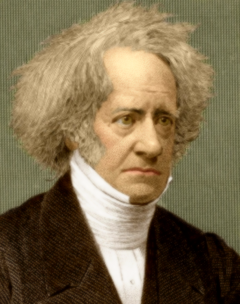
Enceladus is named after a giant from Greek mythology. The name was suggested by William Herschel's son, John Herschel. He thought it was a good idea to name Saturn's moons after the Titans and Giants, because in mythology, Saturn (known as Cronus to the Greeks) was their leader.
The mountains, craters, and other features on Enceladus are named after people and places from the famous book The Book of One Thousand and One Nights (also known as Arabian Nights).
Orbit and Rotation
Enceladus is one of Saturn's major inner moons. It orbits Saturn at a distance of about 238,000 kilometers (148,000 miles) from the planet's center. It completes one orbit every 32.9 hours.
Enceladus is in a special orbital relationship with another moon, Dione, called an orbital resonance. For every one orbit Dione completes, Enceladus completes two. This regular gravitational pull from Dione stretches and squeezes Enceladus, creating heat inside the moon. This process, called tidal heating, is what keeps its hidden ocean liquid and powers its geological activity.
Like Earth's Moon, Enceladus is tidally locked with its planet. This means the same side of Enceladus always faces Saturn as it orbits.
Source of Saturn's E Ring
The huge plumes of ice and dust erupting from Enceladus are the source of one of Saturn's rings. The E ring is the widest and outermost of Saturn's main rings.
The material shot out from Enceladus's geysers escapes the moon's gravity and spreads out into orbit around Saturn, forming this faint, dusty ring. The Cassini spacecraft confirmed this in 2005 when it flew near Enceladus and detected a large number of ice particles.
Geology of an Active Moon
Surface Features
The surface of Enceladus is very diverse. It has old areas covered with many impact craters, but it also has smooth, young plains with very few craters. This mix of old and young terrain shows that Enceladus has been geologically active for a long time, with processes like "water volcanism" (called cryovolcanism) renewing its surface.
Some of the craters on Enceladus look soft and flattened. This is because the ice on the surface slowly flows over millions of years, causing the sharp edges of craters to slump and relax.
The Famous Tiger Stripes
The most exciting features on Enceladus are found in its south polar region. This area is covered in long, parallel cracks that are unofficially called the "tiger stripes." These are deep fissures in the ice crust that are warmer than the surrounding areas.
These tiger stripes are the source of the giant plumes. They are the youngest features on the moon, and the ice around them is coarse-grained and has a different color, suggesting it is very fresh.
South Polar Plumes
The Cassini spacecraft discovered that huge jets of water vapor, ice crystals, and simple organic chemicals erupt from the tiger stripes. More than 100 of these geysers have been identified.
These plumes shoot material hundreds of kilometers into space. Some of the material falls back to the surface as snow, while the rest escapes to form Saturn's E ring. The plumes are most active when Enceladus is farthest from Saturn in its orbit, because the gravitational pull opens the cracks wider.
A Hidden Ocean Under the Ice
The discovery of the plumes was the first major clue that Enceladus has a liquid ocean. By studying Enceladus's gravity and the way it wobbles as it orbits Saturn, scientists confirmed that there is a huge, global ocean of salty liquid water hidden beneath the moon's icy shell.
This ocean is thought to be about 26 to 31 kilometers (16 to 19 miles) deep, which is much deeper than Earth's oceans. The ice shell covering it is about 30 to 40 kilometers thick.
What Is in the Ocean?
The Cassini spacecraft flew directly through the plumes several times to analyze what they are made of. It found that the plumes are mostly water vapor, but they also contain salts, silica (sand-like particles), and a variety of organic molecules, which are the building blocks of life.
The presence of these materials suggests that there are hydrothermal vents on the ocean floor of Enceladus. These are like hot springs on Earth's ocean floor, where hot, mineral-rich water flows out from the moon's rocky core.
Could There Be Life on Enceladus?
Enceladus is now considered one of the best places in our solar system to search for extraterrestrial life. This is because it has all the key ingredients that scientists believe are necessary for life as we know it:
- Liquid Water: A vast, salty ocean.
- An Energy Source: Heat from tidal forces and chemical energy from hydrothermal vents.
- The Right Chemicals: Organic molecules, nitrogen, and minerals like phosphates, which are essential for life.
The discovery of molecular hydrogen in the plumes is particularly exciting. On Earth, some microbes use hydrogen as a food source. While this does not prove that life exists on Enceladus, it shows that the environment in its ocean could potentially support living organisms.
Exploration of Enceladus
The Voyager Missions
The first spacecraft to get a close look at Enceladus were Voyager 1 and Voyager 2 in the early 1980s. Their images revealed a surprisingly bright and smooth surface, which was a big puzzle for scientists at the time. They suspected the moon was active, but they didn't know how.
The Cassini Mission
The Cassini spacecraft, which orbited Saturn from 2004 to 2017, revolutionized our understanding of Enceladus. It performed many close flybys of the moon, discovering the water plumes, confirming the subsurface ocean, and analyzing the chemicals within the plumes.
Cassini provided strong evidence that Enceladus is a habitable world, meaning it has the right conditions for life to exist.
Future Missions
The amazing discoveries at Enceladus have made it a top target for future space missions. Scientists and engineers are designing new probes that could one day return to Enceladus. Some proposed missions, like the Enceladus Orbilander, would orbit the moon and then land on its surface to collect samples and search for signs of life in the material that has snowed down from the plumes. These missions could help us answer one of the biggest questions: are we alone in the universe?
See also
 In Spanish: Encélado (satélite) para niños
In Spanish: Encélado (satélite) para niños


